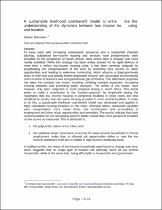 ResearchSpace
ResearchSpace
Sustainable livelihood cost-benefit model to enhance the understanding of the dynamics between low income housing and location
JavaScript is disabled for your browser. Some features of this site may not work without it.
- ResearchSpace
- →
- Research Publications/Outputs
- →
- Journal Articles
- →
- View Item
| dc.contributor.author |
Biermann, SM

|
|
| dc.date.accessioned | 2007-07-02T07:15:31Z | |
| dc.date.available | 2007-07-02T07:15:31Z | |
| dc.date.issued | 2006-12 | |
| dc.identifier.citation | Biermann, SM. 2006. A sustainable livelihood cost-benefit model to enhance the understanding of the dynamics between low income housing and location. Town and Regional Planning, pp. 1-24 | en |
| dc.identifier.uri | http://hdl.handle.net/10204/833 | |
| dc.description.abstract | To keep pace with increasing urbanisation pressures and a substantial inherited backlog, subsidised low-income housing and services have predominantly been provided on the peripheries of South African cities where land is cheaper and more readily available. While this strategy has been widely praised for its rapid delivery of more than a million low-income housing units, it has been severely critiqued for perpetuating the marginalisation of the poor by restricting their access to urban opportunities and leading to extensive commuting, which absorbs a disproportionate share of their time and already limited disposable income, with associated environmental costs in terms of resource use and greenhouse gas emissions. The alternative proposed has been the compact city model, involving curtailing outward expansion, increasing housing densities and promoting public transport. The merits of this model, have however, only been subjected to scant empirical testing in South Africa. This article seeks to make a contribution to the “location-question” by empirically testing the hypothesis that low income housing in peripheral localities is more costly and less beneficial to society than the same housing provided in more central localities. In order to do this, a sustainable livelihood cost-benefit model was developed and applied in eight subsidised housing locations in two cities. Amongst others, measured variables were transportation costs, travel times, fuel consumption and accessibility to employment and other urban opportunities and amenities. The results indicate that more central localities do not necessarily perform better overall than more peripheral localities on the scores as measured. | en |
| dc.language.iso | en | en |
| dc.subject | Low income housing | en |
| dc.subject | Urbanisation pressures | en |
| dc.subject | Poverty | en |
| dc.subject | Livelihoods | en |
| dc.title | Sustainable livelihood cost-benefit model to enhance the understanding of the dynamics between low income housing and location | en |
| dc.type | Article | en |
| dc.identifier.apacitation | Biermann, S. (2006). Sustainable livelihood cost-benefit model to enhance the understanding of the dynamics between low income housing and location. http://hdl.handle.net/10204/833 | en_ZA |
| dc.identifier.chicagocitation | Biermann, SM "Sustainable livelihood cost-benefit model to enhance the understanding of the dynamics between low income housing and location." (2006) http://hdl.handle.net/10204/833 | en_ZA |
| dc.identifier.vancouvercitation | Biermann S. Sustainable livelihood cost-benefit model to enhance the understanding of the dynamics between low income housing and location. 2006; http://hdl.handle.net/10204/833. | en_ZA |
| dc.identifier.ris | TY - Article AU - Biermann, SM AB - To keep pace with increasing urbanisation pressures and a substantial inherited backlog, subsidised low-income housing and services have predominantly been provided on the peripheries of South African cities where land is cheaper and more readily available. While this strategy has been widely praised for its rapid delivery of more than a million low-income housing units, it has been severely critiqued for perpetuating the marginalisation of the poor by restricting their access to urban opportunities and leading to extensive commuting, which absorbs a disproportionate share of their time and already limited disposable income, with associated environmental costs in terms of resource use and greenhouse gas emissions. The alternative proposed has been the compact city model, involving curtailing outward expansion, increasing housing densities and promoting public transport. The merits of this model, have however, only been subjected to scant empirical testing in South Africa. This article seeks to make a contribution to the “location-question” by empirically testing the hypothesis that low income housing in peripheral localities is more costly and less beneficial to society than the same housing provided in more central localities. In order to do this, a sustainable livelihood cost-benefit model was developed and applied in eight subsidised housing locations in two cities. Amongst others, measured variables were transportation costs, travel times, fuel consumption and accessibility to employment and other urban opportunities and amenities. The results indicate that more central localities do not necessarily perform better overall than more peripheral localities on the scores as measured. DA - 2006-12 DB - ResearchSpace DP - CSIR KW - Low income housing KW - Urbanisation pressures KW - Poverty KW - Livelihoods LK - https://researchspace.csir.co.za PY - 2006 T1 - Sustainable livelihood cost-benefit model to enhance the understanding of the dynamics between low income housing and location TI - Sustainable livelihood cost-benefit model to enhance the understanding of the dynamics between low income housing and location UR - http://hdl.handle.net/10204/833 ER - | en_ZA |





